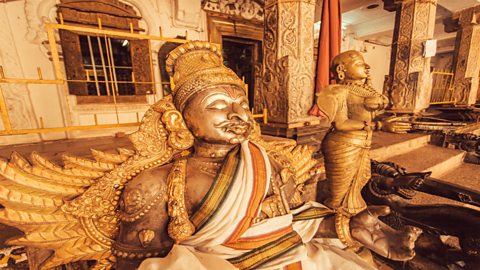Worship in the temple
A Hindu temple is called a mandirThe word many Hindus use for a place of worship - a shrine or special place in the home or a building used by the community for worship and other events.. It is a sacredHoly, related to God. Connected to a religious purpose. place for Hindu worship. There are hundreds of mandirs in the UK. In India, where most Hindus live, most cities and towns contain many temples, and there are temples in almost every village.
Temples contain murtiA statue of a god or goddess which has been made holy through a special ceremony; a term for any statue of a god or goddess. of gods and goddesses. They often honour the gods and goddesses with beautiful decoration, sculpture and lighting. Hindu worship can also happen in open-air shrineTomb or monument to a saint or other holy person., which are more common in India than in the UK.

How are the gods and goddesses represented in mandirs?
Historically in India, mandirs were devoted to only one Hindu god or goddess. VaishnaviteHindus who focus their worship on the god Vishnu. temples housed a central image of Vishnu and murtis of associated gods and goddesses, such as Lord RamaA Hindu deity, the hero of the Ramayana story, another avatar of Vishnu., SitaThe divine consort of Rama. or KrishnaHindu deity, an avatar of Lord Vishnu. There are many tales of him as a mischievous but loving child.. ShaiviteHindus who focus their worship on the god Shiva. temples housed images of Shiva and murtis of the goddesses associated with Shiva, including Lady ParvatiA Hindu goddess often portrayed as Lord Shiva's romantic partner and Lord Ganesh' mother. Parvati represents the continuity of life. , shaktiThe Hindu term for female representations of the ‚ÄėSupreme Spirit‚Äô ‚Äď literally means ‚Äėstrength‚Äô., Durga and Kali.
In India, where there are many Hindus, it is often still the case that mandirs are devoted to only one god or goddess. However, in the UK, many mandirs include lots of different shrines to all the gods and goddesses worshipped in the local community.
What do Hindus do in a mandir?
When they enter a mandir, a Hindu worshipper typically removes their shoes as a sign of respect and cleanliness in the house of the deity / deitiesOne god or goddess. In Hinduism, the word for gods and goddesses that many Hindus believe are different aspects of the one Supreme Spirit (Brahman).. The worshipper then enters the shrine room and rings a bell at the shrine of one of the gods or goddesses. This is a symbol of awakening the deity but it also acts to focus the worshipper’s mind. They may then walk around the shrine while singing, chantRepeating religious phrases or quotations from sacred texts. or praying. They may also present an offering, such as fruit, milk or money.
The purpose of worship in the mandir is to ‚Äėhave darshanMeaning ‚Äėsight/viewing‚Äô. In Hinduism the aim of worship is to experience seeing a deity, and a deity seeing the worshipper and, because of this, blessing them. of (or see) the gods and goddesses. Worship enables the devotee to clearly see ‚Äď and be seen by ‚Äď the Divine. Prayers and hymns (such as bhajanThe Hindu word for songs in praise of the divine. Some are general and others are about particular gods and goddesses.) help the devotee to experience the divine presence. Hindu teaching says that worship comes from human hearts and minds, and is expressed in actions.
The daily services of the mandir usually include morning and evening arti (arati)An act of worship and of adoration, using diva lamps made from cotton wool and ghee (purified butter). ceremonies led by a BrahminA Hindu social group with the duty of teaching others, sharing wisdom and performing sacred rituals, which includes educators and priests. priest. The priest’s role is to look after the murtis of the gods and goddesses in the temple by washing them and clothing them each day. The priest also feeds the gods and goddesses by placing blessed food, called prashadFood that is offered to deities (often as part of worship) and believed by some Hindus to therefore carry divine blessings., at their feet. This food is then shared out with worshippers in the temple or given to people in need.
Question
What does it mean to ‚Äėhave ĽŚ≤Ļįý≤ű≥ů≤Ļ≤‘‚Äô of the gods and goddesses?
Darshan is sight. It means to see the gods and goddesses through devoted practice of worship, and to be seen by the gods and goddesses.